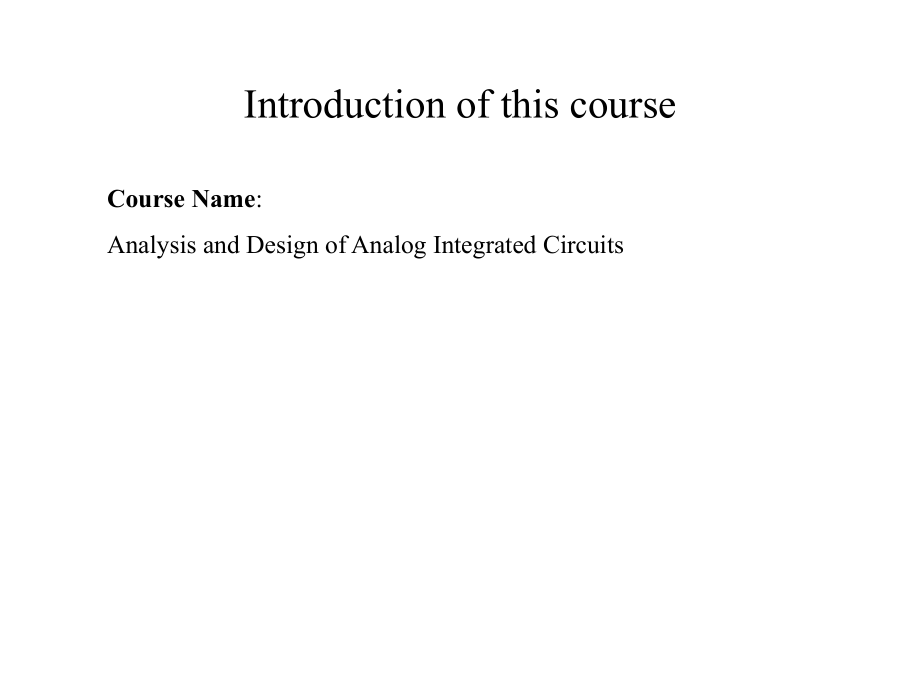 模拟集成电路的分析与设计:Chapter 1-Introduction
模拟集成电路的分析与设计:Chapter 1-Introduction



《模拟集成电路的分析与设计:Chapter 1-Introduction》由会员分享,可在线阅读,更多相关《模拟集成电路的分析与设计:Chapter 1-Introduction(21页珍藏版)》请在装配图网上搜索。
1、Introduction of this courseCourse Name: Analysis and Design of Analog Integrated CircuitsIntroduction of this courseText book(英文版教材)英文版教材): 1、Behzad Razavi, 模拟CMOS集成电路设计(影印版),清华大学出版社, 2005。中文翻译教材中文翻译教材: : 1、模拟CMOS集成电路设计 作者:毕查德拉扎维,译:陈贵灿、程军、 张瑞智出版社:西安交通大学出版社 ,2003。Main reference book(参考书)(参考书): 1、CMOS
2、模拟集成电路设计(第二版)作者:phillip E. Allen, Douglas R. Holberg译:冯军、李智群出版社:电子工业出版社,2005。Introduction to Analog DesignWhy analog? (1)1. Processing of Natural SignalsNatural signals are analog, while many signals we used are digitalSo we need ADC to convert an analog signal to digital signal and then use DSP to
3、process the digital signal.Fig. 1.1a Digitization of a natural signalsIntroduction to Analog DesignWhy analog? (2)1. Processing of Natural SignalsWell some times, the natural signals are very small, or there exist many interferers (干扰). In this case, the small signal cannot be converted directly int
4、o digital correctly. Therefore, an amplifier (放大器)and a filter (滤波器)are needed before converting.Fig. 1.1b Addition of amplification and filtering for higher sensitivity (灵敏度)Introduction to Analog DesignWhy analog? (3)2. Digital communicationsA digital signal through a long cable will be attentuate
5、d and distorted.Multi-level signal processing maybe needed to reduce the required transmission bandwidth (传输带宽)Need a DAC in the transmitter to produce multiple levels from the grouped binary data and an ADC in the receiver to determine which level has been transmitted.Fig. 1.2 Attentuation(衰减) and
6、Distortion (失真) of data through a lossy cableIntroduction to Analog DesignWhy analog? (4)Fig. 1.3 Multi-level signaling to reduce the bandwidthIntroduction to Analog DesignWhy analog? (5)3. Disk Drive Electronics The signal received from the magnetic head is really weak and the noise is quite high.J
7、ust like Fig. 1.1b, there needs amplification, filtering and ADC for further processing.Fig. 1.4 Data stored in and received from a hard diskIntroduction to Analog DesignWhy analog? (6)3. Wireless Receivers A radio-frequency (RF,射频) signal received by a cell phone (手机)is usually only a few microvolt
8、s and its center frequency is usually 1Ghz or higher, while the value of the interferers are higher.Therefore, a high frequency of amplifier and filter are needed.Fig. 1.5 Signal and interferers received by the antenna of a wireless receiver.Introduction to Analog DesignWhy analog? (7)4. Optical Rec
9、eivers High frequency signals are not suitable for transmitting over long distance in the traditional cable due to the severe interference and considerable attenuation because of the limited bandwidth of the cable.In this case, the electrical high frequency signals are converted into the optical sig
10、nals first by the laser diode, then these optic signals are transmitted by an optical fiber, which has extremely wide band and very low loss.In the other end, the optical signals are converted into electrical signals again by the photodiode.Introduction to Analog DesignWhy analog? (8)Since the elect
11、rical current converted by a photodiode is very small, the receiver after the photodiode must process a low-level signal at a very high speed, which requires a low noise, broadband circuit design. Fig. 1.6 Optical fiber systemIntroduction to Analog DesignWhy analog? (9)5. Smart sensors When the car
12、hits an obstacle, the drop in the speed is measured as acceleration. If this acceleration exceeds a certain threshold, the air bag will be released.Since the change of the capacitance is quite small, the electrical signal received is very weak and the there exist large interference, hence the amplif
13、ication, filtering and ADC are needed to handle these small signals properly.Fig. 1.7 Differential accelerometer used in the ABS (安全气囊) system of a car.Introduction to Analog DesignWhy CMOS (1)?CMOS is widely used in digital circuit design due to its low power and low fabrication cost.In the old age
14、, bipolar is often used in the analog circuit design because the speed of the CMOS is not high enough.After scaling down again and again, the speed of CMOS is greatly increased. Nowadays, it is comparable with BIP. Introduction to Analog DesignWhy CMOS (2)?Combining with other advantages, it is time
15、 for CMOS to replace bipolar in the analog IC design.The most important force to apply CMOS technology to analog design is the possibility of placing both analog and digital circuits on the same chip so as to improve the overall performance and reduce the cost of packaging.This is often called as mi
16、xed IC design, which is very hot in IC design nowadays.Introduction to Analog DesignLevel of abstractionFig. 1.8 Abstraction levels in circuit design数模混合IC设计实例(1)采用硅微机械加工技术的植入式记录电极及其在大鼠体内的记录结果采用硅微机械加工技术的植入式记录电极及其在大鼠体内的记录结果 植入生物体的微电子电路在临床上已广泛应用于心率调节、人工耳蜗、人工视网膜修复、泌尿控制与功能性神经肌肉电刺激、以及癫痫和脊柱损伤等康复医疗中。无线植入式神
17、经信号采集系统神经信号记录电极2. 体内至体外无线数据传送通路1. 体外至体内的无线能量及控制数据传送通路数模混合IC设计实例(2)数模混合IC设计实例(3)新型新型8通道低噪声神经信号前端放大芯片通道低噪声神经信号前端放大芯片8通道前端芯片关键指标工艺0.35m CMOS process带内等效输入噪声2.602 Vrms 总面积1700m2479m通道增益46.38dB 5kHz电源5V低频截止点8.2 Hz功耗/CH39.79uA/CH高频截止点10.71K HzTHD(1%)8.1mV共模抑制比70 dB8通道前端芯片版图数模混合IC设计实例(4)低功耗低功耗12位差分位差分SAR A
18、/DADC电路框图ADC芯片照片ADC芯片关键指标工艺0.35m CMOS process信噪失真比58.3dB 1.253kHz分辨率12bit无杂散动态范围72.6dB 1.253kHz采样速度20KS/s有效位9.4bits电源3.3V微分非线性2.2LSB输入幅度2Vpp differential积分非线性2.5LSB数模混合IC设计实例(5) 433M Class E 功率放大器功率放大器433M Class E 功率放大器版图主要参数主要参数结果结果工艺最小尺寸/VDD0.18um/1.8V芯片面积(mm2)1.4*1.4功耗(mW)12S11(dB)-11S22(dB)-15功率
19、增益(dB)11.8附加功率效率(PAE)38%Materials provided in this Lecture (1)(1) Introduction(2) Basic MOS Device Physics (基本MOS器件物理)(3) Single-Stage Amplifiers (单级放大器)(4) Differential Amplifiers (差分放大器)(5) Current Mirrors (电流镜)(6) Frequency Response of Amplifiers (放大器频率响应)(7) Noise (放大器噪声)(8) Feedback (放大器反馈)(9)
20、Operational Amplifier (运算放大器)(10) Stability and Frequency Compensation (稳定性与频率补偿)(11) Bandgap References (带隙基准源)(12) Oscillators, VCO (振荡器,压控振荡器)(13) Phase-Locked Loops (锁相环)Introduction to Analog Design Questions for chapter 1 :(1) Why analog design needed in Processing Natural Signals?(2) Why analog design needed in Digital Communications? (3) Why analog design needed in Disk Drive Electronics? (4) Why analog design needed in Wireless Receivers ?(5) Why analog design needed in Optical Receivers ?(6) Why analog design needed in Smart Sensors ?(7) Why CMOS?
- 温馨提示:
1: 本站所有资源如无特殊说明,都需要本地电脑安装OFFICE2007和PDF阅读器。图纸软件为CAD,CAXA,PROE,UG,SolidWorks等.压缩文件请下载最新的WinRAR软件解压。
2: 本站的文档不包含任何第三方提供的附件图纸等,如果需要附件,请联系上传者。文件的所有权益归上传用户所有。
3.本站RAR压缩包中若带图纸,网页内容里面会有图纸预览,若没有图纸预览就没有图纸。
4. 未经权益所有人同意不得将文件中的内容挪作商业或盈利用途。
5. 装配图网仅提供信息存储空间,仅对用户上传内容的表现方式做保护处理,对用户上传分享的文档内容本身不做任何修改或编辑,并不能对任何下载内容负责。
6. 下载文件中如有侵权或不适当内容,请与我们联系,我们立即纠正。
7. 本站不保证下载资源的准确性、安全性和完整性, 同时也不承担用户因使用这些下载资源对自己和他人造成任何形式的伤害或损失。
